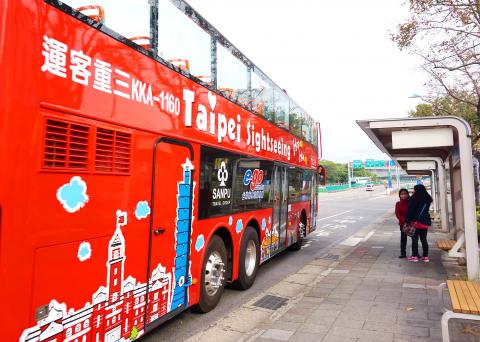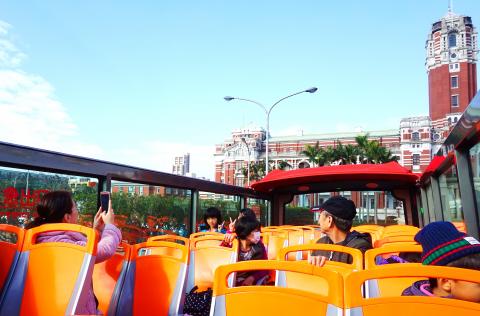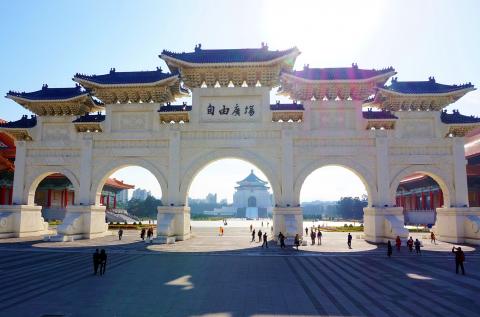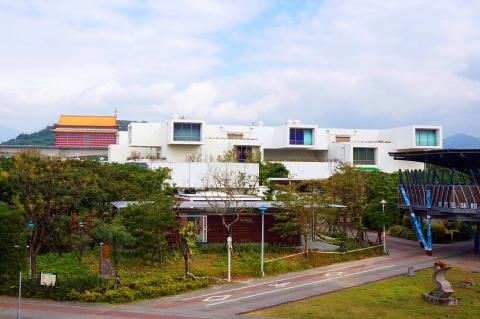Juggling two smartphones and a stack of pamphlets, the harried bus attendant welcomes me aboard. He hands me an English-language brochure that doubles as a map along with a paper cut-out that can be folded into a red double-decker bus. I save that as a gift for my four-year-old cousin.
Thus began my journey on Taipei’s first “hop-on, hop-off” double-decker bus service, launched last month as part of an initiative of the Taipei City Government to attract more foreign tourists to the city.
“Don’t think about it as, ‘I’ve lived here for eight years and been to all the sites,’” were my editor’s instructions. “Bring your camera and fanny pack. Play tourist for a day.”

Photo: Dana Ter, Taipei Times
ALL ABOARD
Stop 1: Taipei Main Station. I opt for the blue north-south route. The red east-west route consists of more malls and markets than actual sites. I’m wearing a poncho and cat lady sunglasses. No fanny pack.
There are no tourists on the bus at 9am. There’s a Taiwanese family with three children taking pictures incessantly, a man in a checkered sweater picking his nose and an old man sleeping with his head pressed against the glass.

Photo: Dana Ter, Taipei Times
The latter two don’t seem very attentive to the sites whizzing by, such as North Gate, or Beimen (北門), the gateway to historic Dadaocheng (大稻埕), once a thriving hub for international commerce in the late Qing Dynasty and now speckled with arts and craft stores and tea houses.
The loudspeaker blares upbeat, staccato music and I feel like I’m entering Frontierland in Disneyland. Looking at my pamphlet, one of the “must-visits” is Taipei’s “distinctive humanistic bookstores.” I don’t see any names, addresses or opening hours for these bookstores. The description does, however, boast of the city’s “fascinating book fragrance culture” — a literal translation of shuxiang wenhua (書香文化), which alludes to a literary or scholarly atmosphere.
I open my map. Most sites on both routes — Chiang Kai-shek Memorial Hall (中正紀念堂), Taipei Fine Arts Museum, the Taipei 101 — are easily accessible via MRT. In fact, half of the stops on the red route are MRT stops — Da-an Forest Park, Zhongxiao Fuxing, Sun Yat-sen Memorial Hall. NT$300 for a four-hour pass and NT$500 for a day pass seems like a hefty price to pay when an MRT ride between two stops is only NT$16.

Photo: Dana Ter, Taipei Times
TOO EARLY FOR NIGHT MARKETS
Stop 2: Ximen (西門), West Gate. The Red House. The century-old building was once home to a theater, the audio guide says.
We pass the Presidential Office Building. The mother herds her three children to the side of the bus to snap a picture. They barely have time to pose before we whiz by the next site, Taipei Guest House. Another eerie-looking structure built during the early Japanese era.

Photo: Dana Ter, Taipei Times
Stop 3: Chiang Kai-shek Memorial Hall. Checkered sweater is still picking his nose. Old man is snoring. The kids are screeching and pointing at Liberty Square (自由廣場). I wonder why no one is getting off the bus. Isn’t the purpose to hop on and hop off?
Stop 4: The Ambassador Hotel, one of the first five-star hotels to open in Taipei in 1962. I ask the bus attendant what there is to do around the area. He says there’s not much besides Ningxia Night Market (寧夏夜市). It’s 9:25am.
Stop 5: Tatung Company (大同). Not much to see here either besides Shuangcheng Street Night Market (雙城街夜市). I look ahead and notice that one of the main attractions at Stop 7 (Jiantan MRT) is yet another night market, Shilin (士林夜市).
There should be a suggestion in the pamphlet that says that the blue route is more suited for nighttime touring. A night pass, valid from 6pm to 10pm, is NT$400.
Maybe the point of the tour is to view Taipei from a bird’s-eye perspective. I try to ignore the Disneyland music and look out at the temples, vegetable stands and office buildings passing by. The experience is the usual assault on the senses — motorcycle fumes, cars honking, pounding from construction sites — things that could be avoided had I taken the MRT.
TRIP CUT SHORT
Stop 6: Taipei Fine Arts Museum (TFAM). Checkered sweater, old man and screeching children are still on the bus. No new passengers have hopped on. I decide to hop off here, and the attendant reminds me that the buses come every 40 minutes.
It’s just after 9:30am and my friend who works at the museum invites me in for tea. I spend over an hour mesmerized by Wang Hsin’s (王信) photography of the Tao people of Orchid Island and the surreal landscapes of Kashmir.
I enjoy the museum so much that I miss the 10:50am bus. The plan was to hop back on and get off at Stop 8, the old residence of former president Chiang Kai-shek (蔣介石).
I decide to abort the trip at this point. By the time the next bus reaches my destination, the residence would be closed for lunch (from 12pm to 1:30pm), and my four-hour pass would be expired when it reopens. And the idea of perusing antiques at the final stop, the National Palace Museum, with busloads of Chinese tourists just doesn’t seem appealing to me.
If the government were to launch a bus service to take tourists to places not easily accessible by other means of public transport — for instance, hiking trails or hot springs in Yangmingshan, tea farms in Muzha or perhaps a day trip to Yilan — the NT$500 for a full-day pass would be more worth it.
Instead, I end my morning chowing down chicken curry and naan bread with another friend at Masala Art in Maji Square near TFAM. At least I won’t be reeking of night market stinky tofu when I take the MRT home.

June 23 to June 29 After capturing the walled city of Hsinchu on June 22, 1895, the Japanese hoped to quickly push south and seize control of Taiwan’s entire west coast — but their advance was stalled for more than a month. Not only did local Hakka fighters continue to cause them headaches, resistance forces even attempted to retake the city three times. “We had planned to occupy Anping (Tainan) and Takao (Kaohsiung) as soon as possible, but ever since we took Hsinchu, nearby bandits proclaiming to be ‘righteous people’ (義民) have been destroying train tracks and electrical cables, and gathering in villages

This year will go down in the history books. Taiwan faces enormous turmoil and uncertainty in the coming months. Which political parties are in a good position to handle big changes? All of the main parties are beset with challenges. Taking stock, this column examined the Taiwan People’s Party (TPP) (“Huang Kuo-chang’s choking the life out of the TPP,” May 28, page 12), the Democratic Progressive Party (DPP) (“Challenges amid choppy waters for the DPP,” June 14, page 12) and the Chinese Nationalist Party (KMT) (“KMT struggles to seize opportunities as ‘interesting times’ loom,” June 20, page 11). Times like these can

Dr. Y. Tony Yang, Associate Dean of Health Policy and Population Science at George Washington University, argued last week in a piece for the Taipei Times about former president Ma Ying-jeou (馬英九) leading a student delegation to the People’s Republic of China (PRC) that, “The real question is not whether Ma’s visit helps or hurts Taiwan — it is why Taiwan lacks a sophisticated, multi-track approach to one of the most complex geopolitical relationships in the world” (“Ma’s Visit, DPP’s Blind Spot,” June 18, page 8). Yang contends that the Democratic Progressive Party (DPP) has a blind spot: “By treating any

Swooping low over the banks of a Nile River tributary, an aid flight run by retired American military officers released a stream of food-stuffed sacks over a town emptied by fighting in South Sudan, a country wracked by conflict. Last week’s air drop was the latest in a controversial development — private contracting firms led by former US intelligence officers and military veterans delivering aid to some of the world’s deadliest conflict zones, in operations organized with governments that are combatants in the conflicts. The moves are roiling the global aid community, which warns of a more militarized, politicized and profit-seeking trend